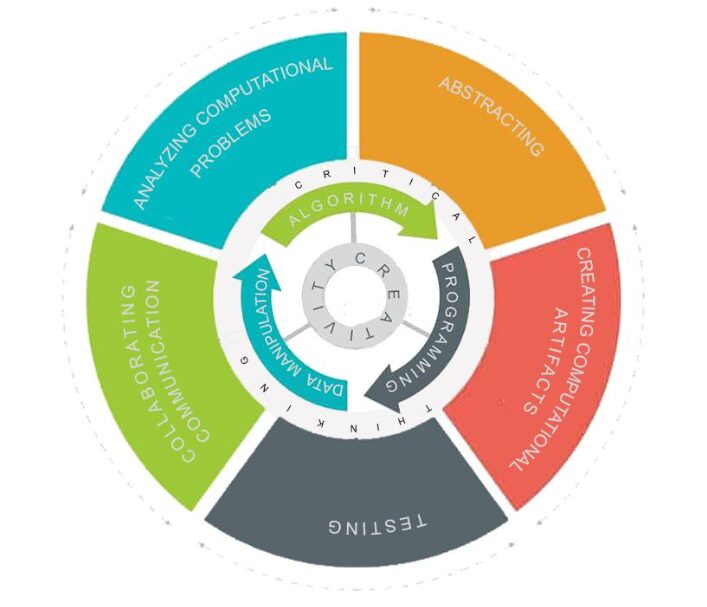ΔΙΑΘΕΜΑΤΙΚΟ ΠΡΟΓΡΑΜΜΑ ΣΠΟΥΔΩΝ / CaR
Στα πλαίσια του προγράμματος οι εταίροι συγγράψαμε ένα πρόγραμμα σπουδών για την εφαρμογή των Εκπαιδευτικών Σεναρίων Ρομποτικής που αναπτύξαμε, εμπλουτίζουμε και εφαρμόζουμε στα σχολεία μας και μετά το πέρας του προγράμματος.
Αυτό το έγγραφο σκοπεύει να παρουσιάσει ένα πλαίσιο ‘Κώδικα και Ρομποτικής’ (CaR) που παρέχει διαφορετικά πλαίσια για μάθηση, συμπεριλαμβανομένων θεμάτων προγραμμάτων σπουδών, θεμάτων σε όλη την εκπαιδευτική διαδικασία- κυρίως μάθηση για την παγκόσμια ιθαγένεια, βιωσιμότητα, τα οποία βασίζονται σε σημαντικές πτυχές της καθημερινής ζωής.
Σε αυτό το έγγραφο σκοπεύουμε να αναλογιστούμε τι θεωρούμε ότι είναι σημαντικό να γνωρίζουν τα παιδιά και επίσης, να ξέρουν πώς να το κάνουν. Δεν μπορούμε να προβλέψουμε ποιες γνώσεις πρέπει να γνωρίζουν τα παιδιά που φοιτούν τώρα στην πρωτοβάθμια και κατώτερη δευτεροβάθμια εκπαίδευση όταν μπαίνουν στην αγορά εργασίας, αλλά υπάρχουν ορισμένα πράγματα που σίγουρα γνωρίζουμε: πρέπει να ξέρουν πώς να επικοινωνούν και να συνεργάζονται με άλλους και πρέπει να μπορούν να λύνουν σύνθετα προβλήματα με τις τεχνολογίες της εποχής τους. Τα προγράμματα σπουδών πρωτοβάθμιας και κατώτερης δευτεροβάθμιας εκπαίδευσης περιλαμβάνουν διάφορες έννοιες με ευρύτερο πεδίο εφαρμογής στις επιστήμες και τα μαθηματικά και κάποιες οδηγίες για τις τέχνες, τον αθλητισμό και τις ΤΠΕ, αλλά λιγότερη προσπάθεια καταβάλλεται στη διδασκαλία της επίλυσης προβλημάτων, της επιστήμης των υπολογιστών, της τεχνολογίας και της ρομποτικής. Η χρήση ρομποτικών συστημάτων και η εισαγωγή της ρομποτικής μπορεί να προσφέρει στα παιδιά τη δυνατότητα να αναπτύξουν τα βασικά της τεχνολογίας και να τους δώσει άλλου είδους ανθρώπινες και οργανωτικές αξίες.
Διαβάστε αναλυτικά το διαθεματικό πρόγραμμα σπουδών εδώ
CaR - Code and Robotics Framework

In this document we intend to list what we consider to be important children should know and also know how to do it. We cannot predict what knowledge children who now attend primary and lower secondary education will need when they enter the job market, but there are some competences that they must have: how to communicate and work with others, and be able to solve complex problems with technologies of their time. Primary and lower secondary education curricula include several concepts with a wider scope in science, mathematics, and some guidance for the arts, sports, and ICT. However, less effort is applied on teaching problem solving, computer science, technology, and robotics. The use of robotic systems and the Introduction of Robotics can bring to children the possibility of developing the basics of technology, while developing other skills , for instance human and organisational values.
This document intends to present a Code and Robotics (CaR) framework that provides different contexts for learning, including cross curriculum topics, global citizenship and sustainability, which rely on important aspects of everyday life.
The framework intends to develop knowledge, skills, attributes and capabilities around three key significant aspects of learning with robotics systems, introducing robotics in Primary and Lower Secondary Education.
This framework is organised into two perspectives: concepts (what students should know) and practices (what students should do).

The concepts are: Creativity, Algorithms, Programming and Data Manipulation.
The practices are:
Analysing computational problems: The students should analyse problems, divide them into parts, and evaluate each part to determine whether a particular computational solution is appropriate.
Abstracting: Students should identify patterns and extract common characteristics from specific examples to create generalisations in order to simplify the development process and manage complexity.
Creating Computational Artefacts: Students should create artefacts that are personally relevant or beneficial to them and their community, combining and modifying existing artefacts or developing new artefacts. Examples of computational artefacts include robotic systems but also drama, dancing and other things that students imagine.
Testing Computational Artefacts: students should test and redefine computational artefacts in an intentional and iterative process.
Communication and Collaboration promotes the creation of situations in which students communicate, collaborate and interact synchronously and asynchronously, using the most appropriate digital platforms for the learning scenarios development. It is important that moments will be created for students to present and share, individually, in pairs or in teams, the development of the learning scenarios and their robotics systems.
 Evaluation of competencies in Robotics Learning Scenarios - Erasmus+ Project KA201 – 2019 - 2019-1-PT01-KA201-061331
Evaluation of competencies in Robotics Learning Scenarios - Erasmus+ Project KA201 – 2019 - 2019-1-PT01-KA201-061331
 Evacomp
Evacomp